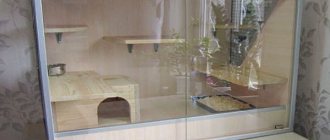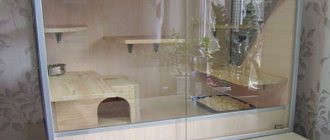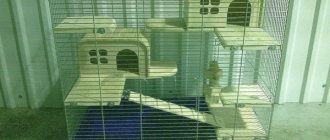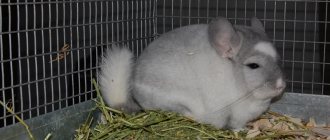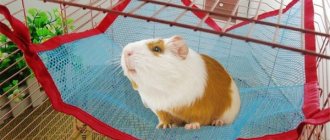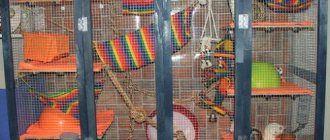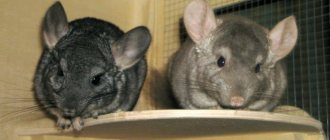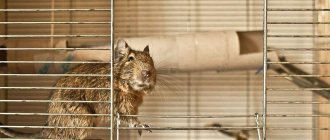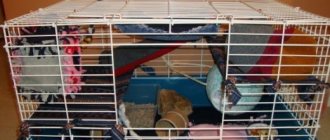If you decide to get a chinchilla as a pet, you should definitely think about where your pet will live. Of course, this place should be cozy and comfortable for the chinchilla, the health and life expectancy of the animal depends on this. A chinchilla cage is an issue that should be taken care of even before you get such a pet, so you need to understand all the intricacies of this topic.
Care and maintenance at home
When you decide to get a chinchilla, it is important to first learn how to care for your pet at home. Proper care and rational feeding are the key to a long life for an animal.
Pet cage and house
Before purchasing a chinchilla, you need to purchase a home for your future pet. It is preferable to keep the animal in a cage, the main criterion for choosing which is spaciousness. The chinchilla is a mobile, active animal that requires enough space. The minimum cage size for one individual is 50x60 cm, excluding the play area. The choice should be made in favor of high cages, since the rodent is characterized by jumping ability.
It is worth paying attention to the material from which the rods are made: they must be metal. The pet will quickly chew through wooden or plastic grilles and run away
Since the chinchilla is flexible, you should not purchase a cage with a large distance between the bars, as this also risks the animal escaping.
Metal cages with a plastic tray are the best solution when purchasing a house for a future pet; they are easy to clean and inexpensive. However, they are not soundproofed; this will be especially noticeable at night. As an alternative, pet stores offer to place the animal in special glass display cases made like an aquarium.
Disadvantages of the showcase:
- the wooden frame absorbs unpleasant odors;
- inconvenient to wash;
- The walls and floor swell from moisture over time, resulting in the need to replace the display case.
Inside the rodent's home, it is necessary to install a wooden house in which the animal will sleep during the daytime and hide from the outside world.
Delicious dinner!
How to maintain?
Keeping a chinchilla will not be particularly difficult if the pet owner takes care of purchasing a spacious cage furnished with the necessary accessories. The animal must be kept clean and always have access to clean water, hay and fresh food.
It is important to monitor the thermal regime; exceeding the air temperature of 25 degrees is fraught with heat stroke for the animal. You can beat the seasonal heat with frozen water bottles placed in your cage.
This will cool the temperature inside the animal's home. It is under no circumstances recommended to install a fan or humidifier in a room with a chinchilla.
In addition to the house, feeder and drinking bowl, the cage must contain a special salt stone on which the animal will grind its teeth. For entertainment, you can equip the cage with a system of manholes and tunnels, which can be purchased at a pet store.
How to toilet train?
Chinchillas are easy to train; if desired, you can accustom them to a tray that serves as a toilet. Preference should be given to the corner option, this will save space in the cage.
To train an animal to relieve itself only in a tray, you should fill it with a special wood filler and regularly collect the animal’s pellets in it. Feeling the smell, over time the chinchilla will understand that the tray is a special place for excrement.
When training your pet to use the toilet, it is important to adhere to the basic rules of training - reward while visiting the litter box and scold for defecating on the floor.
Bathing
The rodent's soft coat requires regular bathing in special seliolite sand, which can be purchased at a pet store. This procedure allows you to clean the animal’s fur from dirt.
Bathing a chinchilla should be carried out in a special bathing suit, on the bottom of which sand is poured in a layer no higher than half a centimeter
It is important that the product is securely fastened to the bars of the cage, so that the vigorous movements of the rodent do not lead to the bathing suit turning over
Bathing a chinchilla
How to care for a sick pet?
Chinchillas, like any representative animal of the animal world, can get sick. The main signs of animal illness are:
- inactivity;
- apathy;
- increased sleepiness at night;
- excessive salivation;
- moans;
- refusal of food;
- pressing the ears to the head.
Any of these symptoms is a good reason to contact your veterinarian. You should not try to treat the animal yourself; only a doctor who will give basic recommendations for caring for a sick pet should make a diagnosis and prescribe a treatment regimen. The owner’s main task during this period is to strictly follow the veterinarian’s recommendations.
Step-by-step instruction
First of all, you need to prepare the tools and consumables that will be used during work. After this, you can begin manufacturing. Do-it-yourself chinchilla cage - step-by-step instructions:
- Cut out the back wall of the display case from the furniture board. It must be solid, since it is on it that all accessories (feeder, wheel, etc.) are attached. It also protects the wall of the apartment next to which the cage stands from destruction - a curious and at the same time active chinchilla is capable of tearing off the wallpaper, chewing the plaster, and tearing off the paint. If you plan for it to stand in a corner and be in contact with two walls, you should cut out both the back wall and the side from a solid panel.
- Cut out the ceiling from the furniture board and, leaving 5-10 cm on each side, cut out a ventilation window with a jigsaw. Subsequently, it will be covered with a mesh. This part can also be assembled from four planks, carefully connecting them together.
- Make the bottom part. It is advisable to make it in the form of a drawer that acts as a tray - this will make cleaning easier, but in this case the floor should be mesh. Garbage and waste will fall through the cells, and the person caring for the chinchilla will only have to pull out the drawer to pour everything in it into a garbage bag.
- Cut strips about 5-10 cm wide and equal to the height of the display case, in the amount of 4 pieces. They will serve as side supports.
- Assemble the frame of the structure by fastening together the parts mentioned in paragraphs 1-4. After this, you can begin installing the glass and mesh.
- Cover the top ventilation window and side walls with mesh. This is done in the following way: from the inside, along the entire perimeter, the mesh is attached with staples using a stapler or screwed with self-tapping screws, and then the joints of the mesh and wood are covered with aluminum strips. This installation option protects the animal from injury from sharp edges.
- Attach the glass doors and insert glass into the side walls, if this was planned. For convenience, the doors can be made double not only vertically, but also horizontally. Then you won’t have to keep the entire display case open to clean, feed or replace accessories.
- Seal all joints with sealant. To prevent your chinchilla from getting poisoned if he decides to chew it, you should use a non-toxic transparent sealant for aquariums.
After this, the cage is ready for use.
What you will need
First of all, a sufficient amount of free time. Making a cage yourself will take about a week if you make it in the evenings after work, or one day off. You can’t do without tools, consumables and an understanding of what the end result should be.
Materials
For most of its life, a chinchilla either sleeps or chews whatever gets in its way. She will definitely test her teeth and her cage, so only natural wood can be used to make a display case. You will have to discard boards that contain chemicals that are harmful to health. These include OSB, fiberboard, chipboard. Before purchasing lumber, you need to make sure that their thickness is at least 1.5-2 cm.
You will also need a metal mesh with very small cells. It is used to cover the ventilation hole in the ceiling of the display case.
Doors and side walls are traditionally made of glass. If desired, you can make one or more (except those adjacent to the walls of the apartment) from a mesh, but this is not the best option for owners. During active games, the animal scatters sawdust, sand, dry food throughout the cage, and all this will fly out through the cells, littering the room.
For the chinchilla itself, mesh walls are preferable, because they have a positive effect on the ventilation of the home
Tools
To work with all of the above materials you will need the following tools:
- Hacksaw (used to cut boards into pieces of the required size).
- Grinding machine (in order to remove all roughness and splinters; you can replace it with abrasive sandpaper).
- Jigsaw (useful for cutting out windows and doors).
- Drill and wood bits.
- Wire cutters (to cut the mesh into pieces).
- Furniture stapler and staples (for fastening; can be replaced with self-tapping screws with a press washer).
- Screwdriver and self-tapping screws (for assembling the structure).
- Ruler and pencil (for marking).
- Sealant (for sealing joints).
Having a woodworking machine will make the work much faster and easier.
Blueprints
To make a cage for a chinchilla with your own hands, it is also advisable to draw the drawings yourself. Firstly, this is the only way to take into account all the nuances of the room where the pet’s home will be located, and secondly, to create a display case that is ideal for a specific animal that has its own preferences and habits.
If this is the master’s first experience in creating such structures, it is not forbidden to use the standard scheme shown in the figure
How to make a chinchilla cage
You can assemble a home for the animal yourself. This usually saves money. Although homemade cages for chinchillas are also not free, they allow you to take into account all the wishes of the animal owner.
A homemade cage will not only fit in size. You can make the necessary changes to the design so that it is adapted to a specific apartment or house.
The chosen level of difficulty is decisive. Simple but proven designs that almost everyone can do.
Tools and materials
To make the cell, prepare everything necessary. Depending on the design, preferences and level of training, the following materials will be required:
- laminated chipboard sheets;
- small boards;
- metal mesh with cells measuring 20 by 20 mm;
- metal tubes, corner;
- building profile;
- plywood;
- electrical tape - for design it is better if it is the same color as the future cage;
- glass 6 mm thick;
- loops;
- lock;
- For the cage in the form of a display case, take an old cabinet.
Tools you will need:
- jigsaw, hacksaw with small teeth;
- self-tapping screws, bolts;
- drill, drill bits;
- pliers, wire cutters;
- screwdrivers, screwdriver;
- welding machine.
Procedure
The nature of the work depends on the model. They start with drawings. They must be detailed and understandable.
It’s easier to make a display case for chinchillas from unnecessary furniture, for example, from a closet. The step-by-step instructions look like this:
- Remove the doors.
- Some shelves are being removed. Free up space for movement. If there are no shelves, nail the crossbars and lay down plywood. Layout - according to the drawing.
- Ventilation holes are made in the upper part of the cabinet and covered with mesh.
- A wooden frame is installed in place of the former doors. Use boards. Another option is “original” doors with a cutout. Leave about 10 cm around the edges.
- Stretch a metal mesh over the frame.
- It would be better if the closet had a drawer at the bottom. Then the floor in the main part of the future display cage is removed.
- Replace it with a mesh. Litter and garbage are flying down. The bottom drawer acts as a pull-out tray. A special tray is placed there.
Sometimes there is no blank in the form of an old cabinet. We have to do without it:
- Laminated chipboard sheets are cut to size.
- Cuts are made in future doors and sides. In the end, only frames remain.
- Cut the metal mesh into the required pieces. You can work with wire cutters.
- The mesh is secured using self-tapping screws. It is advisable to cover the joints, for example, with an aluminum threshold.
- A pallet (base) is assembled from the remnants of laminated chipboard. Height - 8–10 cm. Self-tapping screws are suitable for fastening. It can be reinforced with a stiffening rib - a board glued to the bottom.
- Insert the back and side walls into the tray. They try it on.
- Drill holes at the mounting points.
- Fasten the ties (screws).
- Install the floor and ceiling.
- Special hinges for glass are installed on the doors. The last ones are installed.
- They install shelves and other internal fixtures.
- The doors are being hung.
For more advanced masters, this option is suitable:
- Assembling the frame. Metal tubes are used and corners are used for connections. Fastened with screws.
- The bottom is covered with a mesh. Use a welding machine.
- If cleaning is done through the top of the cage, the bottom is covered with planks. When garbage is collected through the bottom, the structure is supplemented with a pallet.
- The walls are attached to the cage frame.
- If waste is collected through a tray, the top can be closed. In any case, it is advisable to make a removable lid.
- Install the hinges.
- They hang up the door.
- They attach the lock.
How to set up a cage for a chinchilla?
In order for your pet to live comfortably in his cage, it is necessary to properly equip it. You can do this yourself, the arrangement will not take much effort and time, you just need to know some rules. So, what must be in a chinchilla cage:
- House. This is an essential part of the cage; the chinchilla needs a house in order to retire and hide if necessary. It is advisable that it be made of wood or ceramics; the ideal dimensions are considered to be 30*30*30; such a house can easily fit into such a house, and it will be quite comfortable for her to be inside.
- Shelves. Chinchillas love to jump on shelves and sit there, so there should be a lot of them, at least 3 in a cage. It is best to use shelves made of wood, however, special plastic is also considered a fairly good material for this. The shelves must be rough so that the chinchillas’ paws do not slip.
- Drinking bowl. Any person understands that a chinchilla must have clean drinking water in its cage. One drinking bowl will be enough for a rodent; you can buy it at a specialized pet store; it can be made of glass or plastic; it is best to take the ball version. The drinking bowl is attached to the outside of the cage; you can attach it above the shelf, but it is better to be closer to the floor so that the chinchilla always has access to water.
- Feeder. The ideal option would be a feeder made of ceramics, because a plastic feeder will be chewed by your pet on the first day. The feeder can stand on the floor of the cage, or can also be attached to the wall of the cage close to the floor.
- Sennitsa. Chinchillas need to be given hay every day, however, you should not put it on the floor, because this way it can get wet, and wet hay is very harmful to the stomach of this animal. The sennitsa can be a small tube with walls made of fine metal mesh; you should not buy a sennitsa in the shape of a ball, because the chinchilla can climb into it and get injured.
- Running wheel. A wheel is not a necessary item in a chinchilla's cage; it can live without it. But with a wheel, your pet will have much more fun, and besides, by running in it, the chinchilla can throw out its accumulated energy. If you nevertheless decide to purchase a wheel for your pet, then it should be made of wood, and the surface on which the chinchilla will run should be rough. The diameter of the wheel should be about 40 centimeters so that the rodent can comfortably fit in it. The wheel must be firmly attached to the cage; be sure to check this, because if it comes off, it can lead to the death of the animal.
- Toilet. Chinchillas go about their business not just anywhere, on the floor in a cage. Stores sell a special one, which is a tray; it must be placed at the bottom.
- Stones. Pet stores sell special stones with which chinchillas can sharpen their teeth and nails, as well as receive some minerals from them. The stones need to be attached to the wall of the cage, not only on the floor, but also above the shelf.
- Hammock, tunnel. Some chinchillas simply don't use these attributes, so you may not need them. You need to decide for yourself whether your pet needs this entertainment.
If you set up your chinchilla's cage correctly, he will be happy and healthy, and therefore will live a long life with you.
Dimensions
As mentioned above, size is important. How comfortable the animal will be depends on it; its health directly depends on it.
For one animal
It is advisable to choose a cage with dimensions of 80x80x50 cm. With such dimensions the pet will not feel cramped. But still, acquiring a more spacious living space will only be a plus.
For two chinchillas
The size of the cage must be at least 140x140x80cm.
For breeding
The size of the cage should be much larger than normal. Such farmer cells are an amalgamation of smaller cells. It is desirable that each such cell be 50x50x40 cm in size. It is necessary to build a corridor between them so that the male can calmly pass to the females. At the same time, isolate the females from each other. This can be done by putting special plastic collars on the females.
Do-it-yourself housing for a chinchilla
Often breeders decide to make a chinchilla cage with their own hands.
If you have a desire to tinker, then here are a few instructions to help you. First, buy the necessary materials for the job. It is better to give preference to wood. The frame will be made of bars, lining, boards and many shelves. Chipboard or plywood are also suitable. To close the holes, you need a metal mesh.
The following tools will be useful:
- hacksaw;
- jigsaw;
- hammer;
- drill and wood bits;
- stationery knife, marker;
- metal scissors;
- ruler.
To begin, prepare a drawing, taking into account the size of your room and the size of the desired pet house. Then start making the base, which needs to be covered with clapboard.
Next, the cage frame is built from the bars.
The bars are attached to the corners of the base using self-tapping screws or nails.
Using a metal mesh, the walls of the cage and its roof are tightened.
To make cleaning easier, we recommend making several doors on different sides.
Then you can install various shelves and place the accessories your animal needs on them.
It is best to cover the back of the cage with a sheet of plywood.
Finally, it is necessary to treat the house with a protective impregnation.
If you show your imagination, you can use old furniture and other available materials. An old cabinet is often used:
- The doors are removed from the furniture and the inside is repurposed for animals. Some of the shelves are cut out to allow animals to move freely.
- You need to cut a hole in the top of the closet and stretch the mesh so that the house is ventilated.
- In place of the cabinet doors, you can make frames from wood and tighten them with a metal mesh.
A do-it-yourself chinchilla display “from scratch” will require a little more time and skill.
So, you will need:
- metal tubes for the frame, or wooden yards;
- corners to connect parts;
- cogs;
- metal mesh;
- door hinges.
Then follow the instructions step by step:
| Step | Description |
| 1. | First you need to prepare drawings, taking into account the minimum acceptable dimensions for a chinchilla cage. |
| 2. | Next, we assemble the frame from pipes and yards, using corners for reliability, and fasten them with screws. |
| 3. | Make (internal) markings, designating areas for the animal’s life, that is, think about a place for sleeping, playing, toilet, bath, etc. |
| 4. | The mesh bottom is attached to the cage frame. For this you need a welding machine. |
| 5. | Connect the frame and walls of the house. |
| 6. | Next you need to install the door, use hinges and a lock. |
| 7. | Attach accessories inside the house. |
A do-it-yourself corner display case for a chinchilla is quite popular, because it can significantly save space in your apartment. To make one, show a little imagination and dexterity, and the result will definitely please you!
Where to place a chinchilla cage
Take seriously the choice of place in the apartment where the cage with the animal will be placed. It is better not to change the location of the cage throughout the animal’s life.
Here are some tips for you:
- the room should be dry and light;
- direct rays of the sun should not enter the cage;
- drafts should not be allowed;
- the air temperature where the animal lives should not exceed +23° C.
- the cage should not be placed next to electrical heating appliances;
- It is not advisable to place the cage on the floor;
- the cage should not be placed next to loud devices (equipment);
- Since chinchillas are very active at night, you should not place the cage in the bedroom. It's better to put it in the living room.
Cleaning a chinchilla's cage or display case
It is not enough to simply make a house, choose a place for it and move your pet into it; you must also not forget about caring for your pet’s home. Once a week you need to do a general cleaning, and at this time the animal should be placed in a carrier. The house can be wiped with a wet cloth and even vacuumed. At the end of cleaning, you need to wipe the cage dry. Disinfection (if necessary) is carried out using specialized products purchased at a pet store.
Manufacturing
When there is nothing in the house suitable for conversion into a display case, then the most budget-friendly option would be to make a shelter from chipboards. The main thing is not to forget to purchase the necessary tools, building materials and accessories.
To work you will need:
- laminated chipboards as the main material;
- galvanized metal mesh with small cells;
- plexiglass for doors;
- wooden slabs for shelves;
- adhesive tape for processing the edges of the cage, especially in cut areas;
- tie screws and drills;
- nuts, screws, screws;
- accessories for glass doors;
- welding machine;
- Bulgarian;
- self-tapping screws
Before you start designing, you must make a drawing, which you can find ready-made or come up with something of your own. Then you should cut out all the necessary parts. Moreover, this can be done either independently or in a workshop. And only then start working. Don't forget to allocate free space for this.
During manufacturing, a certain pattern should be followed.
- Prepare a drawing based on the measurements taken in advance. It is advisable to carefully double-check everything several times before you start cutting out any important detail.
Adviсe
Making a cage is not difficult if you follow the step-by-step instructions, which are very easy to follow. You just need to take into account some nuances in the work.
- The cage frame must be placed in a vertical position only. The animal is too active and therefore a wide and low house is not suitable; living in it will be uncomfortable.
- The materials needed to make the cage must be safe. It is best to take wooden shelves. However, over time, they must be replaced, since the rodent loves to sharpen its teeth.
- To ventilate the cage, you will need a galvanized mesh with small cells, which is placed on one or both sides.
- Glass used in arranging doors or walls will help maintain order. At the same time, be sure to take only high-quality accessories in order to avoid any elements falling out that could easily injure the animal.
- It is advisable to install locks on the doors - magnetic or with a key. The chinchilla is very curious and loves to crawl into cracks. And if, while jumping, he accidentally hits the door, he can easily open it and quickly escape.
- You definitely need to buy a special hanging hammock or sew it yourself. It is intended not only for entertainment, but also for relaxation. You can swing on it with pleasure.
- The main thing is that the cage is comfortable for the animals to live in, and convenient for the owners to clean.
Chinchillas bring incredible joy to all family members. In addition, they live a very long time, of course, if they eat right and spend a lot of time in motion. And this requires a lot of space. Consequently, ready-made cells purchased in a store are small and inconvenient in this case. As a result, preference is given to display cases made independently.
To learn how to make a chinchilla cage with your own hands, see the following video.
Requirements
Regardless of whether the chinchilla cage is purchased ready-made or made independently, it must meet certain standards. This will provide the pet with proper living conditions in the future. Housing should not only be comfortably decorated, dry, bright, illuminated, but also have good ventilation.
In addition, several characteristics are important for the design
Minimum size
Keeping an adult chinchilla requires a lot of space: the dimensions of the cage should not be less than 50 cm in length and width and 70 cm in height. If the cage is small, the animal’s activity will decrease and it will begin to get sick more often.
To keep several individuals, the above parameters must be multiplied by the number of animals.
This size will be quite enough for the pet to have a place to rest, eat and play.
Distance between mesh bars
To protect the animal, this figure should be no more than 20 mm. Otherwise, the “fluffies” will be able to easily get out.
Free access for cleaning
To facilitate the process of cleaning the house, the presence of a retractable tray in the design, where you can pour small shavings or sawdust, will help. If you purchase a cage with a fixed floor, then cleaning it will be difficult and inconvenient.
Today, cages for chinchillas are presented in a huge assortment, and each type differs not only in size, design, but also in price. Several cage designs are best suited for keeping this type of animal.
Showcase
It is made in large sizes and is intended for group breeding of pets. As a rule, such models are purchased by those who plan to professionally breed chinchillas. Showcases are made from various materials, but wooden construction is in particular demand.
A cage made of wood is considered environmentally friendly and looks attractive, but it must be additionally lined with dense material, otherwise pets will quickly gnaw through the walls of the structure. You can also make display cases from durable plywood and glass.
Box of twigs
This is a common type of cage that can be found in every pet store at an affordable price. Additionally, the boxes are equipped with houses, which allows you to save money on arranging housing for the animal. Such cages can be disassembled into separate parts, they are convenient to store and transport in bags. In addition, the boxes are easy to clean. The only drawback of such models is that products made from rods are not able to absorb sound.
DIY design
It can be multi-tiered, three-story, corner and wall. For more convenient operation, owners make structures on wheels using old cabinets and chests of drawers. The main advantage of such a house is that it can be assembled from any available material according to an individual design.
Most often, homemade structures are made from plywood, planks and glass, but their assembly requires some experience and time.
Additional accessories for chinchillas
Placing an animal in a new cage is only the first stage of creating a cozy atmosphere for it. In order for a chinchilla to enjoy life, be healthy and active, its place of residence will need to be provided with additional details. What's on this list?
House
One of the mandatory additions to the cage. You can immediately buy a metal cage or a wooden one, or a profile display case with a house. And if you have purchased a display case, or the simplest metal cage, or you want to independently organize a place of residence for a South American rodent, you will need to provide a home for the pet as the main addition. This way the animal can climb into it at any time and rest. The size of the sleeping place is slightly larger than that of an adult chinchilla, because they like to lie down at their full height.
Cozy homemade house for a rodent
Feeder
An essential element of the cage, which is best attached to the bottom or wall of the cage, and should also be washed systematically. There are no restrictions on materials. The most convenient option is a plastic food bowl. The main thing is that it has a comfortable shape for the animal and is moderately deep.
Feeder attached to the cage wall
Drinking bowl
Another important accessory that will need to be attached to the bars of the wall or door. It should always contain clean and fresh water, and the structure itself should not allow leaks. Unlike the feeder, it cannot be placed on the floor, otherwise the water may become contaminated. The breeder can choose one of two common drinker options - ball or nipple.
It is better to attach a glass drinking bowl to a cage
It is necessary to select the one that will be convenient for a particular pet. Another important nuance is that you should not buy a plastic drinking bowl, otherwise the chinchilla can quickly chew through it. The best option is glass.
Sennitsa
She's a feeder with hay. The latter must be present in the chinchilla’s diet to maintain the health of the animal. If you leave hay just like that on the floor, it will soon be naturally distributed throughout the cage. But you should also be careful with the design of the hay feeder. It is best when it is a separate small house. An alternative is to use a small mouse or hamster running wheel that remains closed after the hay is added. The structure will need to be secured first so that the chinchilla does not get hurt.
The best option for feeding hay to a rodent
Stone for chinchilla
It will be needed so that the rodent can periodically sharpen its teeth with its help. Typically, a salt or mineral stone is used for these purposes, which is placed in the same way as a drinking bowl, on the walls of the cells. Otherwise, it may get lost, but it will always be in sight and freely accessible to the pet.
Mineral stone for grinding teeth
Litter tray
Of course, you will need to organize a toilet in the cage, since the chinchilla is a fairly clean animal. Although it was previously mentioned about the need for a pull-out tray under the cage, it is also better to install the tray inside the cage or display case. This will make cleaning much easier and more convenient. Plus, the cage won’t get too dirty or clogged.
For more convenient cleaning and keeping the cage clean, install a chinchilla tray
Sand bath
We have already focused on the cleanliness of chinchillas. In order for them to keep their fur clean, they will need clean sand, as it is preferable to water for animals
A small container is enough, but it should be comfortable for the animal to roll over in it.
Rodent prefers sand baths
